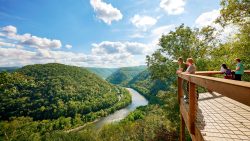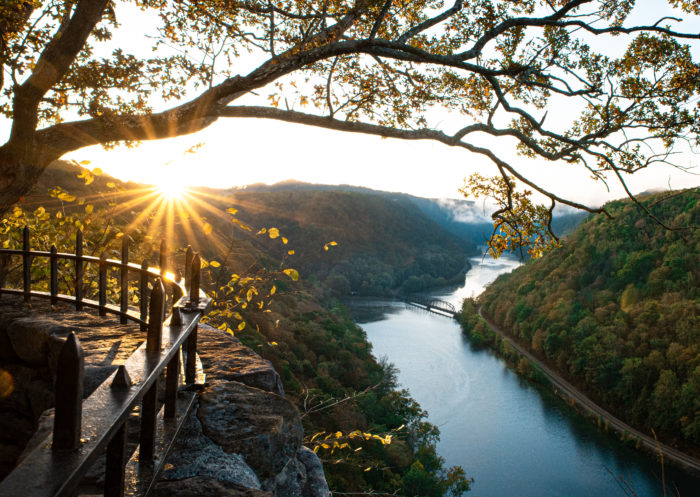9 grandest old arts centers in West Virginia
So many theaters in the Mountain State still shine with their original 20th century grandeur.
Take in a performance at one of these venues, and you might find yourself immersed in the Jazz Age or another colorful era from that theater’s heyday.
These 9 grand old arts centers are just a few you’ll find along West Virginia’s Historic Theatre Trail:
1. Apollo Civic Theatre
After its construction in 1913, the Apollo Theatre was the social and cultural hub of Martinsburg, presenting motion pictures, plays, vaudeville acts and live music.
The theater was designed in Classic Revival style by Reginald Geare, architect for the Knickerbocker Theatre in Washington D.C. It is known for the repeated segmental arches over each bay. Today you can enjoy classic films, plays, community gatherings and a youth summer theater workshop.
2. Randolph Community Arts Center
The Randolph Community Arts Center in Elkins got its start as St. Brendan’s Catholic Church in 1928. The church was designed in Romanesque Revival style by Walter F. Martens, architect of the Governor’s executive mansion in Charleston.
After the church congregation left in 1999, the Randolph Community Arts Council bought the building, renovated it and reopened in 2001 as an exhibit and performance space. Its notable Great Hall still has the original lighting fixtures and religious icons of the church.
3. Star Theatre
This old-fashioned movie theater in Berkeley Springs was built in 1916 as a car storage garage. After a renovation, it reopened as the Berkeley Theater in 1928. During its last major renovation in 1949, they added the signature light-up marquee.
The single-screen Star Theatre shows 1 film at a time, and changes every weekend. Moviegoers line up in the concession room, which was once the town’s telephone exchange, to buy buttered popcorn made in the original 1949 Manley popcorn machine.
4. Carnegie Hall
One of only 4 Carnegie Halls in the world that’s still in continuous use, this theater was built in 1902 by philanthropist Andrew Carnegie as a classroom and performance space for the Lewisburg Female Institute. Designed in Greek Revival style by architects Barrett & Thompson, the building is now an arts and education center for the Greenbrier Valley and the cultural heart of the Lewisburg Historic District.
5. Landmark Studio for the Arts
Landmark Studio for the Arts in Sutton is another example of a historic theater that started out as a church. Built in 1886 in the Victorian style, the arts studio still has the Methodist church’s original 20-foot stained glass window, woodwork and steeple.
In 1988, they added a stage and dressing rooms, and in 2003 came new floors, doors and a roof. Landmark’s resident community theater group performs here, and sponsors a youth troupe, too.
6. Pocahontas County Opera House
This Victorian-style opera house, built in 1910, was the first of its kind in West Virginia, with concrete walls reinforced with steel railroad rails. In its early years, the building was not only a venue for plays, vaudeville shows and solo artists, but also a basketball court, roller skating rink and religious sanctuary for the Marlinton area.
The theater closed in the late 1920s, and the building had phases as an automobile dealership and lumber storage warehouse before its restoration to its original glory. Today, the Pocahontas County Opera House brings in a variety of live performances, and is part of the Mountain Music Trail.
7. Keith-Albee Performing Arts Center
The crown jewel of Huntington, the Keith-Albee Theatre opened in 1928 as a vaudeville and movie house. Its Spanish Baroque design was the vision of architect Thomas Lamb, whose attention to detail took the original $250,000 budget up to $2 million.
The theater seated 3,000, which made it second in size only to the Roxy in New York City. Today the theater still has its lavish original décor, and is the home venue for the Marshall Artists Series, which brings in top live music, dance and theater performances.
8. Robey Theatre
The Robey Theatre in Spencer boasts an impressive claim to fame: it is the longest continuously operating theater in the country.
Hamond Robey built the theater in 1911 specifically for films, then in 1926 he remodeled it to the design you see today. In the late 1920s, the Robey became one of the first theaters in the area to install sound equipment. It still shows films nightly, 364 days a year.
9. Capitol Theatre
Opened in 1928, Wheeling’s Capitol Theatre owes its Beaux Arts style to architect Charles W. Bates. Described as a “marvel of harmonious beauty,” the theater is known for its arched windows, classical details and bas-relief panels.
For 35 years, the theater was the venue for “Wheeling Jamboree,” the country’s 2nd longest-running radio program. It is now home to the Wheeling Symphony Orchestra, and features a variety of nationally touring acts and local performances.
What historic arts centers have you visited?
This post was last updated on July 21, 2020








